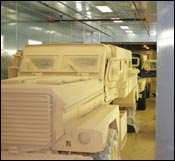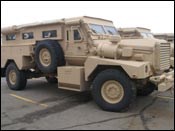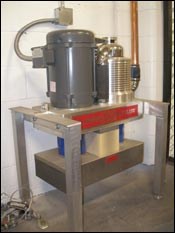How to Maximize CARC Spraying Efficiency
Fleet Image uses a combination of finishing technologies
#curing #pollutioncontrol #basics
Little expense is spared when it comes to protecting the troops on the front line. In terms of finishing, this means the use of chemical agent resistant coatings (CARCs) on all tactical equipment. U.S. Army regulations specify that ground support equipment, tactical wheeled vehicles and aircraft be both protected against the effects of chemical warfare agents and be able to withstand the degradation caused by cleaning and decontamination procedures in the aftermath of a chemical attack.
As a result, most military vehicles and equipment are now painted with CARCs—highly crosslinked topcoats that keep radioactive, biological and chemical contamination from penetrating the coating and the substrate. CARC finishes also must resist chemical attack from harsh cleaning agents used to decontaminate military vehicles.
Featured Content
Over the past few years, high-performance water-reducible CARCs have gained acceptance. The new materials meet volatile organic compound (VOC) objectives and contain no hazardous air pollutants (HAPs).
Waterborne CARCs may be good for the environment, but they present challenges to applicators. They’re expensive, so it’s important to control film thickness and minimize overspray and other paint losses. And, drying the materials can be a time-consuming process in extreme climates. Fortunately, paint technology has been developed to deal with both issues.
Painting the ILAV
In Iraq, much of the current focus is on making the transition from U.S. troops to the Iraqi Army as the primary security force. One way to help bring this about is by supplying the Iraqis with the equipment necessary to do the job. Along those lines, last spring BAE Systems (York, PA) received a $188.3 million order from the U.S. Army Tank-Automotive and Armaments Command to manufacture 398 light armored vehicles for the Iraqi Army.
Dubbed (appropriately enough) the Iraqi Light Armored Vehicle (ILAV), the 32,000-lb, all-wheel drive vehicle features an armor-plated V-hull that provides a high degree of protection from improvised explosive devices (IEDs), mines and other hazards. It carries a driver and co-driver and up to eight other troops ready for rapid deployment.
According to defense analysts, the vehicle’s V-shaped bottom hull deflects blasts out the sides instead of allowing the force of the blast to move straight up, damaging the vehicle and possibly causing it to flip.
Work on the contract began in June 2006, and the first ILAVs were delivered by the end of August 2006. The total value of the contract could reach $445.4 million and 1,050 vehicles if all options are exercised.
BAE Systems (York, PA) is the prime contractor for the project. It extended subcontracts to two partners, Force Protection Inc. (Charleston, SC) and Spartan Motors Inc. (Charlotte, MI). Spartan manufactures custom chassis and vehicles for the recreational vehicle, fire truck, ambulance, emergency-rescue and specialty vehicle markets. The company employs approximately 900 at plants in four states.
Right next door to Spartan’s main plant in Charlotte is Fleet Image CARC Paint Div. In addition to other jobs for Spartan and other customers, Fleet paints all the ILAVs manufactured at the adjacent facility.
“CARC is applied to the ILAVs at a 3-4 mil dry film thickness,” explains Fleet president Brian Brandt. “Right now we’re spraying the lowest-VOC CARC available, and there’ll be another one coming soon that’s even lower.
Fleet’s 16,000 sq ft shop features a vehicle wash facility, paint mixing room, and a 64 × 20 × 15 ft crossdraft paint booth supplied by Global Finishing Solutions (Osseo, WI; see sidebar). The booth features a curing cycle that operates to 160°F, although the CARC used on the ILAV is cured at 125°F, according to Brandt.
Painting two ILAVs at a time keeps Fleet busy, and Brandt says the company is looking at doubling its square footage and adding another paint booth to keep up with demand.
Finishing that many vehicles also means that Fleet was using a lot of CARC. “We were spraying such a large volume of CARC that we had to look into some kind of equipment that would help us save paint,” Brandt recalls.
 |
| Finished ILAVs at Spartan’s Charlotte, MI, facility await shipment to port and eventually to deployment in Iraq. |
Turbine Power
What Brandt eventually found was turbine-based high-volume, low-pressure (HVLP) spray equipment manufactured by Can-Am Engineered Products Inc. (Livonia, MI). Unlike a conventional compressor, the Can-Am turbine delivers a large volume of air directly and continuously to the spray gun at a constant pressure.
High air flow at very low pressures (1 to 9.25 psi at the spray gun), combined with continuous bleeding of turbine-produced air by the gun, means there is no sudden expansion of air coming out of the spray gun as there can be with conventional air or high-pressure systems. The result is a significant reduction in paint fog or bounce-back, minimal overspray, and a significant increase in transfer efficiency.
The system’s high-speed turbine heats air all the way through the lines, allowing it to expand naturally and improving paint atomization, according to Can-Am. Temperature increases through each stage of the turbine, reaching 130-190°F above ambient when it exits the system. The hot air is also said to speed evaporation on the paint surface to shorten drying times.
 |
| Fleet’s floor-mounted Can-Am turbine HVLP system increased transfer efficiency, resulting in a 40% reduction in paint usage and painting cycle time. |
The turbine equipment can be installed on a floor-mount, mobile or centrally piped wall-mount unit. Centrally piped systems can be valved throughout 300 feet of your painting area. At Fleet, the unit sits on the floor near one corner of the paint booth.
Other benefits of the turbine HVLP system include a patented mounting stand that’s said to reduces turbine sound levels to below OSHA standards at a 3-ft distance, speedier paint application, relatively low energy consumption, and a cleaner environment for workers.
“Before, we were using HVLP guns with pressure pots,” Brandt recalls. “We tried out the Can-Am system and it made a big difference. We used to use eight gal of paint, now we use five. So we’ve been using the system since we started the military contract in June, and it has cut both our material use and painting time by 40%.”
At Fleet, the ILAV paint process starts with a thorough washing of vehicles delivered from Spartan to remove any dirt, grease or other residue from the body surfaces. For this task, the company uses a dedicated high-pressure wash station with its own waste treatment system.
Clean vehicles then move into the paint booth for masking and finishing. One vehicle is painted while the other is being prepared for painting. The CARC, supplied by Hentzen Coatings, Inc. (Milwaukee, WI), is a single-component aliphatic polyurethane that requires no catalyst and thus has a much longer pot life. At Fleet it’s mixed in a dedicated, 400-sq ft mixing room. Painters lay down the CARC as primer and top coats, aiming for a cured film thickness of 3 to 4 mils.
After painting, ILAVs undergo a 10-mile road test, brake testing, and a 2.5-hr government inspection before they’re accepted for service. Finished vehicles are shipped to a Maryland seaport before deployment to Iraq. According to one defense analyst, there have been no deaths in the ILAV since its deployment in August 2006.
RELATED CONTENT
-
Curing Oven Basics
Simply heating up the substrate does not cure the coating. There are many variables to consider when choosing the best cure oven for your application...
-
Quality Finishing: Don’t Starve Your Spray Gun for Air!
Tips to Avoid Pressure Drop in Air Spraying
-
Phosphate Conversion Coatings
Types of phosphate conversion coatings, how to apply them, and their specific functions.























